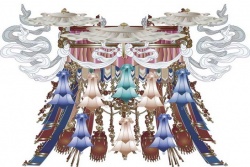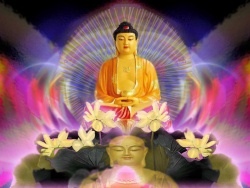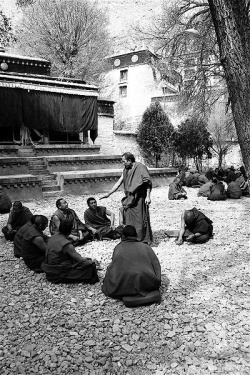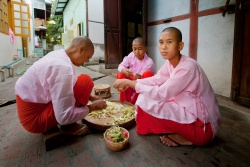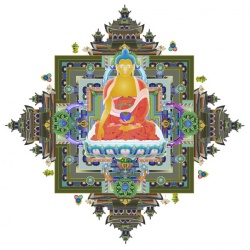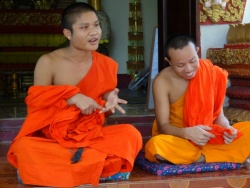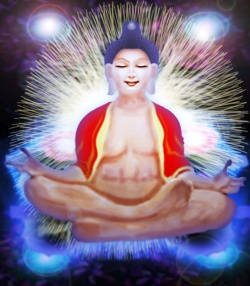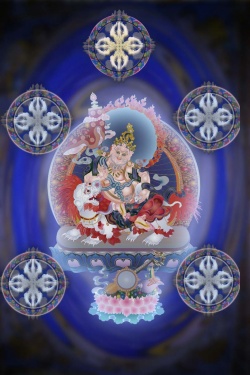Seon
Seon (Sŏn, 禪) is the Korean variant of Chán. Meaning "Meditation," the term is more widely known in the West in its Japanese variant Zen.
Contents
- 1 History of Seon
- 2 Nine Schools
- 3 Korean bhikṣu of the Seon school
- 4 Jinul
- 5 Hyesim
- 6 Jogye Order
- 7 Joseon Kingdom (1392-1897)
- 8 Seosan
- 9 Late Joseon Kingdom
- 10 Korean Empire (1897-1910) and Japanese annexation (1910-1945)
- 11 Division of Korea (1945-present)
- 12 Contemporary Seon
- 13 Spread in the USA
- 14 Kyong Ho
- 15 Characteristics of Seon
History of Seon
Unified Silla Period (668–935) Transmission of Chán to Korea
Seon was transmitted into Korea during the Unified Silla Period (668-935). Beomnang (法朗, Pŏmnang, Peomnang) (632-646), who studied with the fourth Chinese Patriarch Dayi Daoxin (道信) (580-651), was the first to bring Seon to Korea. Pŏmnang transmitted his teachings to Sinhaeng (神行) (704-779), who also traveled to China. Sinhaeng studied with Puji (651–739), a successor of Yuquan Shenxiu (died 706), the head of the so-called Northern School of Chinese Chán. Seon was further popularized by Doui (道義) (died 825) at the beginning of the ninth century.
Nine Schools
Seon was gradually further transmitted into Korea, as Korean monks of predominantly Hwaeom (華嚴) and Consciousness-only (唯識) background began to travel to China to study the Chán of Hongzhou school of Mazu Daoyi (709–788) and his successors , and the Rinzai school of Linji Yixuan.
Mazu's successors had numerous Korean students, some of whom returned to Korea and established their own schools at various mountain monasteries with their leading disciples.
Initially, the number of these schools was fixed at nine. Korean Seon was termed the "nine mountains" (九山 or gusan) school at the time.
Eight of these were of the lineage of Mazu Daoyi (馬祖道一) (709-788), as they were established through connection with either him or one of his eminent disciples. The one exception was the Sumi-san school founded by Ieom (利嚴) (869-936), which had developed from the Caodong (曹洞) lineage.
Toǔi (道義 Doui) (died 825), who studied with Zhizang (735-814) and Baizhang (百丈) (749-814) is regarded as the first Patriarch of Korean Sŏn. He founded the Kaji Mountain school (迦智山 Gaji san school). The Nine mountain Schools adopted the name Jogye in 826. The first record of the Nine Mountains school dates from 1084.
Goryeo Dynasty (918–1392)
Korean bhikṣu of the Seon school
Tension
By the eleventh century Sŏn Buddhism became established in Korea. It distinguished itself from the existing Five Schools and their scriptural emphasis. Tension developed between the new meditational schools and the previously existing scholastic schools, which were described by the term gyo, meaning "learning" or "study". Efforts were needed to attain mutual understanding and rapprochement between Sŏn and these scholastic schools.
Jinul
The most important figure of Seon in the Goryeo was Jinul (知訥) (1158-1210), who established a reform movement in Korea. In his time, The Sangha was in a crisis of external appearance and internal issues of Doctrine. Buddhism had gradually become infected by secular tendencies and involvements, such as fortune-telling and the offering of prayers and rituals for success in secular endeavors.
This kind of corruption resulted in the profusion of increasingly larger numbers of monks and nuns with questionable motivations. Therefore, the correction, revival, and improvement of the quality of Buddhism were prominent issues for Buddhist leaders of the period.
Jinul sought to establish a new movement within Korean Seon, which he called the "Samādhi and prajñā society". It's goal was to establish a new community of disciplined, pure-minded practitioners deep in the mountains.
He eventually accomplished this mission with the founding of the Songgwangsa monastery (松廣寺) at Mt. Jogye (曹溪山) as a new center of pure practice.
Jinul's works are characterized by a thorough analysis and reformulation of the methodologies of Seon study and practice. He laid an equal emphasis on doctrinal teaching and Sŏn practice. One major issue that had long fermented in Chinese Chán, and which received special focus from Jinul, was the relationship between "gradual" and "sudden" methods in practice and Enlightenment. Drawing upon various Chinese treatments of this topic, most importantly those by Zongmi (780-841) and Dahui Zonggao (大慧宗杲) (1089–1163), Jinul created Pojo Sŏn , a "sudden Enlightenment followed by gradual practice" dictum, which he outlined in a few relatively concise and accessible texts. From Dahui, Jinul also incorporated the gwanhwa (觀話 ppk'an hua[[, "observing the critical phrase") method into his practice. hism.
Hyesim
Chinul’s successor, Chin’gak Hyesim (1178–1234) emphasized the hwadu (Ch. huatou, "[[wor] head]]" or "critical phrase") practice.
He collected 1,125 gongans in his Sŏnmun yŏmsongjip ("The Collection of Verses and Cases", 1226). Hyesim encouraged female practitioners to practice hwadu, where-as women’s Buddhist practice was limited to Chanting and Sūtra-readings.
Jogye Order
It was during the time of Jinul that the Jogye Order, a primarily Seon sect, became the predominant form of Korean Buddhism, a status it still holds. There would be a series of important Seon teachers during the next several centuries, such as Hyegeun (慧勤), Taego (太古), Gihwa (己和) and Hyujeong (休靜), who continued to develop the basic mold of Korean meditationa'l Buddhism established by Jinul.
Taego Bou (1301–1382) studied in China with Linji teacher and returned to unite the Nine Mountain Schools.
Joseon Kingdom (1392-1897)
Suppression
At the end of the Goryeo Dynasty, and during the Joseon Kingdom, the Jogye Order was combined with the scholarly schools. It lost influence under the ruling class, which embraced neo-Confucianism. Buddhism was gradually suppressed for the next 500 years. The number of temples was reduced, restrictions on membership in The Sangha were installed, and Buddhist monks and nuns were literally chased into the mountains, forbidden to mix with society. Joseon Buddhism was first condensed to Seon and Gyo. Eventually, these were further reduced to the single school of Seon.
Giwha (己和; (Hamheo Deuktong 涵虚得通 Hamhô Tûkt’ong) 1376–1433) wrote an important treatise in defense of Buddhism, entitled the Hyeon jeong non. In the tradition of earlier philosophers, he applied che-yong ("Essence-Function") and Hwaeom (sa-sa mu-ae, "mutual interpenetration of phenomena").
During the Joseon Kingdom, the number of Buddhist monasteries dropped from several hundred to a mere thirty-six. Limits were placed on the number of clergy, land area, and ages for entering The Sangha. When the final restrictions were in place, monks and nuns were prohibited from entering the cities. Buddhist Funerals, and even begging, were outlawed. A few rulers temporarily lifted the more suppressive regulations. The most noteworthy of these was the Queen Munjeong. The queen had deep respect for the brilliant Monk Bou (보우, 普雨; 1515–1565), and installed him as the head of the Seon school.
Seosan
Buddhist monks helped in repelling the Japanese invasions of Korea, which occurred between 1592 and 1598. Monks were organized into guerrilla units, which enjoyed some instrumental successes. The "righteous Monk" (義士; uisa) movement was led by Seosan Hyujeong (서산대사, 西山休靜; 1520–1604), a Seon master and the author of a number of important religious texts. The presence of the monks' army was a critical factor in the eventual expulsion of the Japanese invaders.
Seosan made efforts toward the unification of Buddhist doctrinal study and practice. He was strongly influenced by Wonhyo, Jinul, and Giwha. He is considered the central figure in the revival of Joseon Buddhism, and most major streams of modern Korean Seon trace their lineages back to him through one of his four main disciples: Yu Jeong (1544–1610); Eongi (1581–1644), Taeneung (1562–1649) and Ilseon (1533–1608), all four of whom were lieutenants to Seosan during the war with Japan.
Late Joseon Kingdom
Buddhism during the three centuries, from the time of Seosan down to the next Japanese incursion into Korea in the late nineteenth century, did not change very much. The Buddhism of the late Joseon Kingdom saw a revival of Hwaeom studies. There was also a revival of the Pure land (Amitābha) Faith. Tere was never again the extreme suppression of the early Joseon.
Korean Empire (1897-1910) and Japanese annexation (1910-1945)
With the Korean Empire started the Gwangmu Reform, a modernization of Korea. The Korean Empire ended in 1910, when Korea was annexated by Japan.
Korean monks travelled to Japan for the scholarly study of Buddhism, where they were influenced by Japanese scholars who introduced western ideas into their studies. Via those Korean monks western ideas were also introduced in Korean Buddhism, and a bifurcation developed between monks and scholars.
Division of Korea (1945-present)
After the Second World War the United Nations developed plans for a trusteeship administration, the Soviet Union administering the peninsula north of the 38th parallel and the United States administering the south. The politics of the Cold War resulted in the 1948 establishment of two separate governments, North Korea and South Korea.
Contemporary Seon
See also: Religion in Korea, Religion in South Korea, and Religion in North Korea
Since the middle of the 20th century [[Wikipedia:Christianity|Christianity]] has competed with Buddhism in South Korea, while religious practice has been suppressed in North Korea.
Seon continues to be practiced in Korea today at a number of major monastic centers, as well as being taught at Dongguk University, which has a major of studies in this religion. The largest Buddhist denomination is the Jogye Order.
In the 1980s a debate arose about "sudden" versus "gradual Enlightenment". Since Jinul Korean Seon was based on the integration of practice and scholarly study in the slogan "sudden Enlightenment, gradual cultivation". The modern Korean Seon master Seongcheol revived the slogan "sudden Enlightenment, sudden cultivation", ascribed to Hui Neng. The last three Supreme Patriarch's of the Jogye have a stance in this debate that is in accordance with Seongcheol.
Spread in the USA
Korean Seon has been spread in the USA by Seung Sahn. He was a temple abbot in Seoul and after living in Hong Kong and Japan, he moved to the US in 1972, not speaking any English. On the flight to Los Angeles, a Korean American passenger offered him a job at a laundry in Providence, Rhode Island, which became headquarters of Seung Sahn's Kwan Um School of Zen. Shortly after arriving in Providence, he attracted students and founded the Providence Zen Center. The Kwan Um School has more than 100 Zen centers on six continents.
Kyong Ho
Another Korean Zen teacher, Samu Sunim, founded Toronto's Zen Buddhist Temple in 1971. He is head of the Buddhist Society for Compassion'ate Wisdom, which has temples in Ann Arbor, Chicago, Mexico City, and New York City.
In the early 20th century, Master Kyong Ho (1849–1912), renergized Korean Seon. At the end of World War II, his disciple, Master Mann Gong (1871–1946), proclaimed that lineage Dharma should be transmitted worldwide to encourage peace through Enlightenment. Consequently, his Dharma successor, Hye Am (1884–1985) brought lineage Dharma to the United States. Hye Am's Dharma successor, Myo Vong founded the Western Son Academy (1976), and his Korean disciple, Pohwa Sunim, founded World Zen Fellowship (1994) which includes various Zen centers in the United States, such as the Potomac Zen Sangha, the Patriarchal Zen Society and the Baltimore Zen Center.
Characteristics of Seon
Seon is known for its stress on Meditation, monasticism, and asceticism. Many Korean monks have few personal possessions and sometimes cut off all relations with the outside world. Several are near mendicants traveling from temple to temple practicing Meditation. The hermit-recluse Life is prevalent among monks to whom Meditation practice is considered of paramount importance.
Two defining characteristics of Korean Seon are its merging of practice and teaching, and it's use of Hua Tou practice. Korean Seon uses Hua Tou practice as the main koan-practice, instead of the extended koan-curricula which are being used in Japan.
